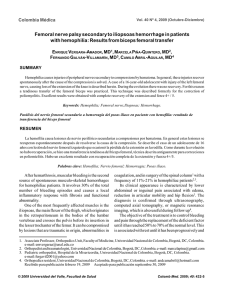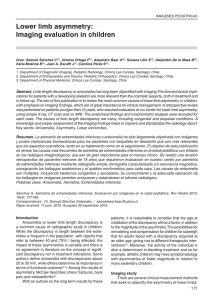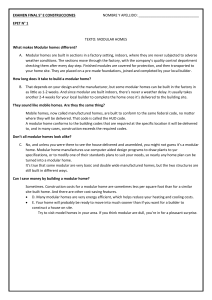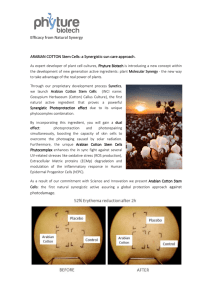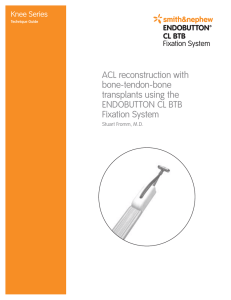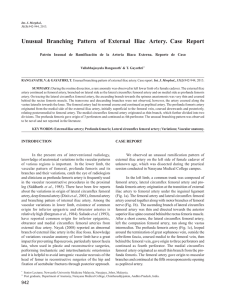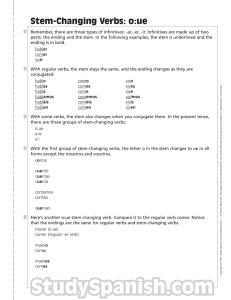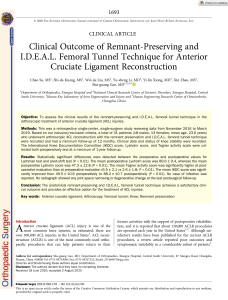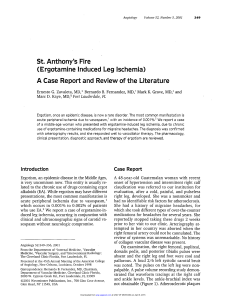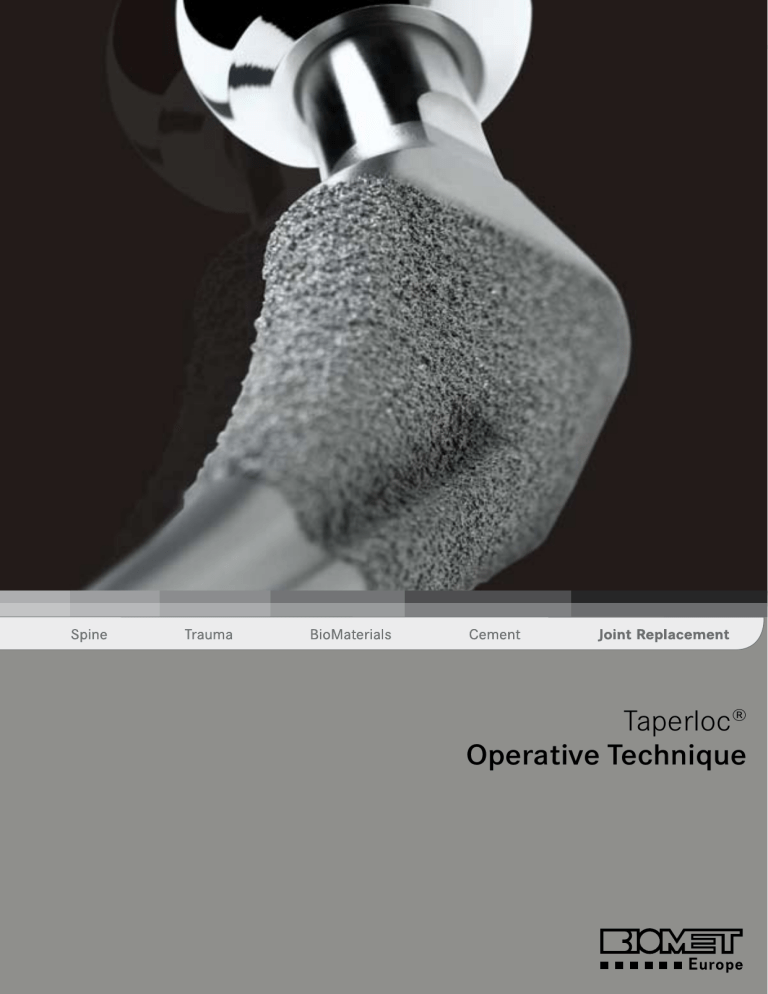
Operative Technique Taperloc® Operative Technique Disclaimer Biomet UK Ltd, as the manufacturer of this device, does not practice medicine and does not recommend any particular surgical technique for use on a specific patient. The surgeon who performs any implant procedure is responsible for determining and utilising the appropriate techniques for implanting the prosthesis in each particular patient. Biomet UK Ltd is not responsible for selection of the appropriate surgical technique to be utilised for an individual patient. Taperloc Hip 1. Pre-operative planning Selection of the correct femoral component is attained through careful pre-operative planning. This can be achieved manually by means of x-ray templates, or digitally by means of a PACS system. Manual pre-operative planning The Taperloc® Hip provides a comprehensive selection of femoral x-ray templates in 110%, 115% and 120% magnification. These templates are positioned over the AP and Lateral x-rays to best decide the correct implant size, modular head neck length and whether a standard or lateralised Taperloc® stem is required to restore the patient’s natural anatomy. Digital pre-operative planning The Taperloc® Hip digital templates are available through various digital template providers. When using digital templating for a primary THR, it is necessary to use a magnification marker with a known dimension. This is required in order for the system to calculate the correct magnification. As soon as the correct magnification has been determined, the system can be used to best decide the correct implant size, modular head neck length and whether a standard or lateralised Taperloc® stem is required to restore the patient’s natural anatomy. Operative Technique 2. Surgical exposure The Taperloc® femoral component can be implanted using any of the standard approaches for total hip replacement. The aim of the approach selected is to provide adequate visualisation of both the acetabulum and proximal femur. 3. Femoral neck osteotomy Once the femoral head has been dislocated from the acetabulum, the femoral neck resection can be completed using the femoral resection template. (Figure 3 & 4) figure 3 figure 4 Taperloc Hip 4. Preparation of the acetabulum and insertion of acetabular component When complete visualization of the acetabulum is achieved, preparation of the acetabulum and acetabular component insertion must be carried out as instructed in the appropriate operative technique. 5. Preparation of the femur To help avoid undersizing, varus positioning and to allow for correct alignment of the reamer and broach, it may be necessary to remove a small section of the medial cortex from the greater trochanter. This can be achieved by one of two methods. The first involves the use of the special box chisel (Figure 5), or by using the starter drill and intramedullary reamer (Figures 6 & 7). Whatever technique is employed, the aim is to provide a lateral starting point for the intra-medullary reamer and broaches. figure 5 figure 6 figure 7 Operative Technique 5a. Reaming the distal femur Once the femoral canal has been located, ream the intramedullary canal with the tapered reamer. (Figure 8) Reaming should not be carried out using power tools. 5b. Broaching the proximal femur figure 8 Starting with the smallest broach available, attach the broach to the broach handle as shown (Figure 9) and begin preparing the proximal femur (Figure 10). It is important to ensure the broach is orientated so that the medial/lateral axis of the broach is parallel with that of the anatomic medial/lateral axis of the femoral neck, as this will determine the angle of anteversion for the implanted femoral component. Sequentially larger broaches are then used until either complete stability is achieved, or the stem size selected during pre-operative planning has been reached. The angled surface of the femoral broach should then be level with the resected femoral neck. (Figure 11) If the femoral broach has finished below the level of the resected calcar, a calcar trimmer can then used to plane the calcar flush with the angled surface of the broach. (Figure 12) figure 10 figure 9 figure 11 figure 12 Taperloc Hip 6. Trial reduction - Broach For cementless and cemented implants the final broach used corresponds with the femoral component to be implanted. (i.e. 12.5mm broach = 12.5mm implant) With the final broach in position, the trial neck can be attached. (Figure 13) The desired trial modular head is then attached to the trial neck and the hip joint reduced. The joint is then assessed for joint stability and leg length. Trial modular heads are available in numerous offsets to facilitate a stable joint. However, should it not be possible attain joint stability without over increasing the leg length, the trial neck is removed and the lateralised version of the trial neck is attached to the broach. The trial reduction procedure is repeated until joint stability and the desired leg length has been achieved. (Figure 14 & 15) figure 13 Standard offset Lateralised offset (Standard +6mm) Once the trial reduction has been completed, carefully remove the trial modular head and trial neck from the broach. The broach handle is then re-attached to the broach and the complete assembly carefully removed from the femur to avoid enlarging the prepared canal. To promote the in-growth of bone into the porous coating, irrigation and drying of the femoral canal is not recommended. figure 14 figure 15 Operative Technique 7. Femoral component insertion – Cementless When implanting a cementless implant, the definitive implant is equivalent to the last broach used. (ie. 12.5mm broach = 12.5mm implant) Select the desired stem and attach it to the inserter handle. (Figure 16) The stem is then impacted until the edge of the porous coating is aligned with the rim of the planed calcar. (Figure 17) The inserter handle is then removed. figure 16 figure 17 Taperloc Hip 8. Femoral component insertion – Cemented When implanting a cemented implant, the definitive implant also corresponds to the last broach used. (i.e. 12.5mm broach = 12.5mm implant) Prior to implanting the desired stem, the femoral canal must be prepared in the following manner. First, the femoral canal must be closed with an adequate cement restrictor. This is used to facilitate the pressurisation of the cement within the femur. The correct size restrictor is selected by using the trials/gauges to correctly size the femoral canal and the restrictor is driven into the femur using the insertion device. It is essential that the restrictor is tight inside the femur and that it is placed at least 2cm distal to the distal tip of the selected implant. Prior to insertion of the cement, it is important that the femur is thoroughly cleaned by pulse lavage and dried to provide a clean dry surface into which the cement can interdigitate. Cementing should always take place in a retrograde fashion. When the canal has been sufficiently filled with cement, the nozzle of the cement gun is shortened and the proximal pressurisation flange attached. The cement gun and pressurisation flange is then re-inserted into the proximal femur and pressurisation continues until immediately prior to stem insertion. The time at which the stem is inserted into the cement will vary on the type of cement used and the theatre temperature. Typically, for Refobacin® R bone cement with a theatre temperature of 21°C mixed in the OptiVac® cement-mixing system, the stem can be introduced 4 - 5 minutes after mixing has commenced. Select the desired stem and attach it to the inserter handle as shown. (Figure 18) The stem is then inserted down the centre of the canal in one continuous movement. During insertion of the stem, pressure must be maintained within the canal by sealing or closing the medial calcar. (Figure 19) Pressure is then maintained on the stem through the inserter handle until the cement has polymerised. figure 18 figure 19 10 Operative Technique 9. Trial reduction - Implant If desired, a further trial reduction can be completed after the implantation of the femoral stem and prior to placement of the modular head onto the taper. (Figure 20) This is important because the femoral component may not in every instance seat exactly to the same depth as the broach and planed calcar. If this is the case, then it is recommended that a further trial reduction is carried out. figure 20 10. Modular head impaction The selected modular head is positioned on the clean male taper of the femoral stem with hand pressure only. Alternatively, a combination of hand pressure and a twisting motion can be used. The modular head is finally seated in position by means of a gentle tap utilising the femoral head impaction device and mallet. (Figure 21) Modular heads should never be heavily impacted onto the trunnion as this may cause damage to highly polished surface of the modular head. figure 21 Once the correct modular femoral head has been attached to the femoral component, the hip joint can be reduced. (Figure 22) figure 22 11 Taperloc Hip 11. Component removal Should a Taperloc® femoral component ever require removal, included in the implant removal tray are two special instruments. These are the modular head removal instrument and the stem removal instrument. The modular head removal instrument locates either side of the taper and exerts a tensile force to eject the femoral modular head. (Figure 23) The stem removal instrument again locates either side of the taper and combined with a slide hammer can exert sufficient force to facilitate removal of the femoral stem. (Figure 24) It is important to note that the stem removal instrument must be used in conjunction with flexible osteotomes to sufficiently loosen the stem. Failure to break the bone/ figure 23 implant or cement/implant interface may result in a fractured femur. figure 24 12 Operative Technique Ordering information Taperloc Femoral Components - Type 1 Taper Stem Diameter mm Stem Length mm Cementless Porous Coated Cemented Porous & HA Coated Standard Lateralised Standard CoCrMo Lateralised Standard Lateralised 6.0 132 103201 11-103201 21-103201 21-123201 - - 7.5 135 164400 103807 21-103202 21-123202 650-0325 650-0331 9.0 137 103203 11-103203 21-103203 21-123203 - - 10.0 140 164401 103808 21-103204 21-123204 650-0326 650-0332 11.0 142 103205 11-103205 21-103205 21-123205 - - 12.5 145 164402 103809 21-103206 21-123206 650-0327 650-0333 13.5 147 103207 11-103207 21-103207 21-123207 - - 15.0 150 164403 103810 21-103208 21-123208 650-0328 650-0334 17.5 155 164404 103811 21-103209 21-123209 650-0329 650-0335 20.0 160 164405 103812 21-103210 21-123210 650-0330 650-0336 Modular Femoral Head Components - Type 1 Taper (T1) Neck Length CoCrMo 28mm Biolox Delta Ceramic 32mm 28mm M2A CoCrMo 32mm MMA 28mm -6mm 163660 163667 - - 164116 -3mm 163661 163668 164135 164185 164117 0mm 163662 163669 164136 164186 164118 +3mm 163663 163670 164137 164187 164119 +5mm - - 164138 - - +6mm 163664 163671 - - 164120 +9mm 163665 163672 - - - +12mm 163666 163673 - - - The modular heads listed above are only suitable for Biomet Femoral Components with Biomet Type1 Taper(T1). Taperloc Femoral Instrumentation for Primary Components - Type 1 Taper (T1) Catalogue Number Description 31-600064 Taperloc Haptic General Instr Tray 31-600065 Taperloc Haptic Rasp Tray 31-600005 Modular Stem & Head Removal Tray 31-600066 Taperloc Haptic 28 & 32mm Trial Modular Head Tray Insert Complete (T1) 31-600432 Taperloc X-Ray Templates (T1) Biomet Femoral Head and Stem Removal Instrument Tray Taperloc Haptic General Instrument Tray Taperloc Trial Head Tray Insert (T1) Taperloc Haptic Rasp Tray Biolox Delta is a registered trademark of CeramTec GmbH. 13 Taperloc Hip Taperloc Femoral Components - 12/14 Taper (12/14) Stem Diameter mm Stem Length mm Cementless Porous Coated Cemented Porous & HA Coated CoCrMo Standard Lateralised Standard Lateralised Standard Lateralised 6.0 132 650-0580 650-0590 650-0550 650-0560 - - 7.5 135 650-0319 650-0349 650-0551 650-0561 650-0337 650-0343 9.0 137 650-0260 650-0263 650-0552 650-0562 - - 10.0 140 650-0320 650-0350 650-0553 650-0563 650-0338 650-0344 11.0 142 650-0261 650-0264 650-0554 650-0564 - - 12.5 145 650-0321 650-0351 650-0555 650-0565 650-0339 650-0345 13.5 147 650-0262 650-0265 650-0556 650-0566 - - 15.0 150 650-0322 650-0352 650-0557 650-0567 650-0340 650-0346 17.5 155 650-0323 650-0353 650-0558 650-0568 650-0341 650-0347 20.0 160 650-0324 650-0354 650-0559 650-0569 650-0342 650-0348 Modular Femoral Head Components - 12/14 Taper (12/14) Neck Length -4mm CoCrMo Biolox Forte Ceramic M2A CoCrMo 28mm 32mm 28mm 32mm MMA 28mm - 53-111232 - 164195 - -3.5mm 53-111228 - 164190 - 650-0130 0mm 53-121228 53-121232 164191 164196 650-0131 +3.5mm 53-131228 - 164192 - 650-0132 +4mm - 53-131232 - 164197 - +7mm 53-141228 - - - - +8mm - 53-141232 - - - +10.5mm 53-151228 - - - - +12mm - 53-151232 - - - The modular heads listed above are only suitable for Biomet Femoral Components with Biomet 12/14 Taper (12/14). Taperloc Femoral Instrumentation for Primary Components - 12/14 Taper (12/14) Catalogue Number Description 31-600064 Taperloc Haptic General Instr Tray 31-600065 Taperloc Haptic Rasp Tray 31-600005 Modular Stem & Head Removal Tray 31-600068 Taperloc Haptic 28 & 32mm Trial Modular Head Tray Insert Complete (12/14) 31-100377 Taperloc X-Ray Templates (12/14) Biomet Femoral Head and Stem Removal Instrument Tray Biolox Forte is a registered trademark of CeramTec GmbH. 14 Taperloc Haptic General Instrument Tray Taperloc Trial Head Tray Insert (12/14) Taperloc Haptic Rasp Tray Operative Technique 15 FLH 105 02/06 Biomet UK Ltd Waterton Industrial Estate Bridgend, South Wales CF31 3XA, United Kingdom Tel. +44 (0)1656 655221 Fax: +44 (0)1656 645454
